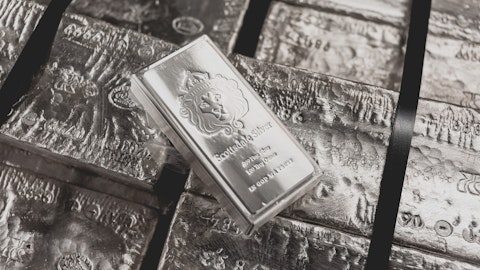Tanya Jakusconek: Okay. Okay. That’s good on the investments. And maybe if I could to follow through, Haytham, on — just on the transaction opportunities. Just want to circle back. You put out a comment that they’re looking at up to $500 million of streaming opportunities. So I want to circle back to, number one, any thoughts of additional platinum palladium opportunities? I personally don’t think Stillwater can take on another ROSE and/or stream, but maybe some of the other items in South Africa and/or their gold assets. I don’t think you’re interested in lithium. Maybe a comment on how that would fit your portfolio.
Haytham Hodaly: Sure. I mean I will keep it simple. We are always looking to add precious metals being gold and silver as a primary two fresh mills. If we can add gold or silver and alongside it add platinum or palladium to top it off to the price that they need, that’s something we could consider. You’re right, I don’t think we would increase Stillwater stream there, but there are other opportunities throughout their portfolio that they are considering.
Randy Smallwood: Saba is a good, strong partner of ours. We’ve had great relationship with Neil and the team there. And so hopeful that we can grow that relationship as we are always hopeful with all of our partnerships. It’s — they’ve got quite a broad selection of assets there, and we’re sure we can help them unlock some value there somewhere.
Tanya Jakusconek: Yes, on the balance sheet repair. So, yes, thank you for that. And then maybe just circling back again on the opportunities, I know I asked all the time all of these big opportunities for balance sheet repair keeps coming up on some of the bigger non-bulk companies and asset sales for the new Crest, Newmont portfolio, et cetera, et cetera. Haytham, I think you mentioned you were looking at 10 or 20, I forget how many you mentioned you were looking at of your deal …
Haytham Hodaly: Yes. I mean we always have at least a dozen on the go. Tanya, we’re probably up closer to 15% right now. Of those, I would say there’s probably a handful that are fairly sizable. But in this environment, there’s no guarantee that the stream will actually get done, but it is, I guess, enlightening to see that streaming is measured alongside debt equity and other forms of capital as well. So there’s definitely people kicking the tires, and we’re there trying to get involved. So …
Randy Smallwood: We are happy to see the equity market waking up a little bit and starting to see some support on that side because we’ve been strong believers that streaming can be the only source of capital. It should be standing alongside a nice balanced spread on that capital. And so happy to see a little bit there because that’s going to open up some opportunities just in that sense, standing alongside some equity raises to fund these developments.
Tanya Jakusconek: And the bigger deals, you said you have a handful of, I think, a, those would be the plus $500 million deals. Can I assume those are pure streaming? Or should I be thinking that there’s equity components plus debt components to total plus 500? Or should it be a simple streaming structure?
Haytham Hodaly: Sure. I mean the majority of those are looking at streaming structures. When you’re looking at opportunities, that’s sizable, Typically, the counterparty does not want to dilute and they have access to debt on their own. For the smaller opportunities, I can tell you there’s — I guess, you would look at a portfolio — not a portfolio, if you look at a number of financing mechanisms alongside streaming.
Tanya Jakusconek: Okay. And so the main financing mechanisms for the smaller ones are what is the stream and plus debt equity would be the structure on …
Haytham Hodaly: That’s correct, Tanya.
Randy Smallwood: We don’t see a lot in the royalty space. The royalties change. I mean, streaming has proven to be much more attractive as a source of capital and royalties. So we don’t — just don’t see new royalties. We see existing royalties being traded around, but not too many people are creating new royalties, especially on advanced projects. If they’re doing royalties, it’s on — stage early — very early stage, kind of ticket create basically royalties so that one day they can put them in a portfolio and try to sell them to companies like us.
Tanya Jakusconek: Okay. Well, we’ll wait for those. Appreciate you taking all my questions and great quarter. Thank you.
Haytham Hodaly: Thanks, Tanya.
Randy Smallwood: Always a pleasure, Tanya.
Operator: Thank you. Your next question is from Richard Hatch from Berenberg. Please ask your question.
Richard Hatch: Yes, thanks. Good morning Randy and team. Thanks for the call. And just got a couple of questions. Just firstly, on the Hecla point, my numbers you made about 50% on that trade. So it’s a good deal. But is there any tax that you’ve got to pay on the sale of those shares or anything we need to be working in there or not?
Gary Brown: The tax — we will have a tax liability associated with that. It will be included at 50% and subject to a 27% income tax.
Randy Smallwood: So standard capital gains of 50% of the gain is taxed at a 27% rate. So net effect is about 15.5% on the total.
Gary Brown : That’s right.
Richard Hatch: Yes. Okay. Very helpful. Second one is just on Salobo. It’s nice to see that asset kind of coming back to performing better again. Just any commentary around the expansion case from Vale or anything that you might be able to add on that, please? — the expansion case, I mean, the hiring higher grading case.
Randy Smallwood: Oh, I see. Okay. Yes, I mean the focus — definitely let Wes add some color to this. But the current focus is, of course, trying to get to the next phase of the expansion payment. And so they’re working their way towards that. Whether they achieve it this year or next year remains to be seen. They’re definitely continuing to improve on Line 3. But as it’s been sort of laid out before the whole site has to perform in order to satisfy that. And so the Line 1 and Line 2, we still got some work to do on that front. But as we’ve seen, this quarter, they actually outperformed even their own expectations, right? And so given that, we think it’s shaping up well for them to hopefully satisfy that. Once that next phase gets satisfied, then we’d be looking at the high grade bonus kicker and actually it starts in the year subsequent to whenever they satisfy Phase 2 of the main expansion payment.
And it’s basically on an annual basis if they meet certain objectives, we’ll make an additional payment towards Vale for satisfying those things. And so that won’t start until next year at the earliest, again, depending on when they finish the Phase 2 of the main expansion payment.
Wes Carson: Yes, I think just to add on to what Randy said there. I mean, really, the focus right now is on getting Salobo III up to its full capacity and really having Salobo I and II built up there as well. The high grade is really an expansion on the open pit and getting some more equipment going in there. And that’s really once they get those plants up and running, then the focus will move over to the mine and then getting that going, I think …
Wes Carson: In the past, they have — just to add, they have talked in the past about the possibility of exploring a Phase IV expansion. And there’s been some discussion about whether that would be an additional 6 million tonnes per annum or 12, whether it’s a full line. And so there is still some discussion and studies going on internally on that front, too. So there’s no doubt there’s still a healthy focus on Slobo.
Randy Smallwood: Absolutely. Well that’s right.
Wes Carson: And — that’s just pure upside for you, right? There’s no extra commitments. You’ve got to pay for that, correct?
Randy Smallwood: Yes. Exactly.
Wes Carson: And then just on that grade upside, are you able to give us any kind of a feel for what kind of higher kind of grade potential we could be seeing from next year if they go down that road?
Randy Smallwood: The channel — sorry, Wes, I’ll step in. The challenge is, it depends on how much they grow their mobile fleet. It depends on how much they push towards the low-grade stockpiling side. And so there’s a number of different factors that they have to balance, stockpile capacity. If they shift more of the low grade towards that, then they could easily push grades substantially higher. If they — it really does come down to what kind of a fleet expansion they go through in the pit. And that’s what will sort of dictate what kind of grades they can deliver to the mills.
Richard Hatch: Yes. Okay. Got you. And then last one is just on Mineral Park, I think if I look at the MD&A, you’ve got $150 million that you could deploy into that one this year. Any kind of steer on timing on that, please?





